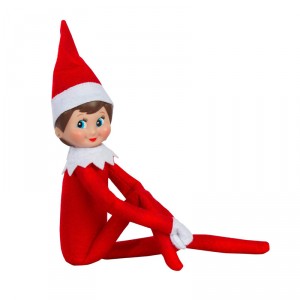Please Take the Elf Off the Shelf!

The Elf on the Shelf has become a family tradition—a very creepy and odd family tradition grossing over 16 million in sales since it debuted in 2005, but a tradition nonetheless. Unfamiliar with the Elf on the Shelf? Well, first, congratulations. You have made it through life without being inconvenienced with the knowledge of its existence. For the sake of this article, however, I must enlighten you.
The Elf on the Shelf is a doll-sized “scout elf” that parents place in various locations of their home around the holiday season. It’s basically a spy for Santa Claus, or, as the product’s promotional material puts it, “Santa’s eyes and ears.” The 2005 book of the same name, written by Carol V. Aebersold and Chanda A. Bell, and illustrated by Coë Steinwart, playfully details how these elves sit in peoples’ homes watching them all day and report back to Santa each night on the children’s behavior. However, it isn’t simply a story. This one has to be believable, and what better way to do that than to include an elf of your very own along with the book?
The idea is for parents to move the elf to a different location each night to suggest that it could be anywhere at any time and is always watching, compelling children to be good lest the elf will report their bad behavior to the big guy. Some parents get creative with the game, going as far as to set up scenes involving the elf getting into something like a jar of candy or making a mess somewhere in the house.
When I was a kid, I was expected to behave to avoid the wrath of my parents, not an elf. The whole idea of the Elf on the Shelf is that it’s just another tool for parents to get their kids to comply. There is a very familiar theme here resembling the concept of God and judgment.
I know many people get into the Elf on the Shelf. It’s one of the most common family traditions these days and kids seem to enjoy it…some of the time. I have a few issues with the whole idea. To begin with, the thing creeps me out. Not only is it set up to be some kind of stalking spy, it actually looks really creepy. One customer on the product’s Amazon page put it into humorous perspective, writing, “My Elf on the Shelf keeps telling me to burn the house down. Is this normal?” to which someone else gamely replied, “Mine told me the same thing—so we hid him in the fireplace. Our nightmare is over now, and we can go back to enjoying the holidays without the stress of hiding a homicidal doll every night.”
But the part that really bothers me is why this toy is even necessary. Shouldn’t we expect our children to behave kindly and respectfully without the invented fear that something or someone is watching us? Shouldn’t we expect to be good people even when we aren’t being “watched”? And what childish behavior is this elf really judging? Every child I’ve seen around this toy, and I’ve seen many, doesn’t seem to enjoy its company as something fun, but instead exhibits confusion and anxiety about it. Kids even question their own natural behavior for fear that they’ll be penalized. Yes, it is just a toy and a children’s book, but it’s a destructive one. What’s the point of placing unnecessary fear into a child’s mind simply so they can “earn” a Christmas present that they were most likely going to get in the first place? It isn’t just for Christians celebrating Christmas, either. Alternative dolls have hit the market like the Mensch on the Bench for Jewish kids, and the CHRISTmas Angel for families who want to focus more on Christianity than Santa Claus.
The whole idea is bizarre to me. This longtime trend of creating a fictitious character to promote fear and elicit submission and obedience is way past its expiration date.
